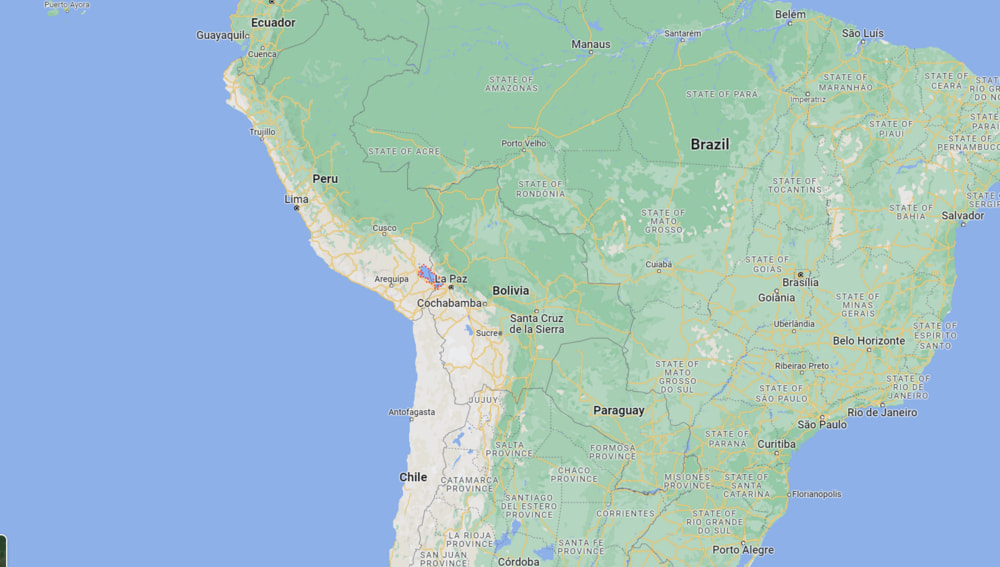Lake Titicaca is a large lake situated in the Andes Mountains on the border of Peru and Bolivia in South America. Here is some information about Lake Titicaca.Location: Lake Titicaca is located in the southern part of the Andes Mountains. It straddles the border between Peru to the west and Bolivia to the east. The lake sits at an elevation of approximately 3,812 meters (12,507 feet) above sea level, making it one of the highest navigable lakes in the world.
Location Map of Lake Titicaca, Peru
 About Map: Map showing Where is Lake Titicaca, Peru located in the Map.
About Map: Map showing Where is Lake Titicaca, Peru located in the Map.
About Lake Titicaca
Lake Titicaca is a large lake situated in the Andes Mountains on the border of Peru and Bolivia in South America. Here is some information about Lake Titicaca.Location: Lake Titicaca is located in the southern part of the Andes Mountains. It straddles the border between Peru to the west and Bolivia to the east. The lake sits at an elevation of approximately 3,812 meters (12,507 feet) above sea level, making it one of the highest navigable lakes in the world. Size: Lake Titicaca is the largest lake in South America by volume of water and the highest commercially navigable lake globally. It has a surface area of approximately 8,372 square kilometers (3,232 square miles) and a maximum depth of around 281 meters (922 feet).
Cultural Significance: Lake Titicaca holds immense cultural and historical importance. It is considered a sacred place by the indigenous people of the region, who believe it to be the birthplace of the Inca civilization. The lake is home to several indigenous communities, such as the Uros people who live on floating islands made of totora reeds. Islands: Lake Titicaca is renowned for its beautiful islands. The most famous ones are the Uros Islands, Amantani Island, and Taquile Island. These islands offer visitors an opportunity to learn about traditional ways of life, experience local culture, and admire the stunning landscapes.
Flora and Fauna: Lake Titicaca supports a rich ecosystem. Its waters are home to several fish species, including a unique type of catfish called "pejerrey." The lake's shores and surrounding wetlands provide habitat for various bird species, such as flamingos, herons, and coots. Tourism: Lake Titicaca is a popular tourist destination, attracting visitors from around the world. Travelers come to explore the islands, visit indigenous communities, and witness the natural beauty of the lake and its surroundings. Boat tours, homestays, and cultural experiences are common activities for visitors. Gateway Cities: The main cities that serve as gateways to Lake Titicaca are Puno in Peru and Copacabana in Bolivia. These cities provide infrastructure, accommodations, and transportation options for travelers visiting the lake.
Lake Titicaca's combination of stunning landscapes, cultural heritage, and unique ecosystems make it a captivating destination for nature lovers, cultural enthusiasts, and those interested in exploring the ancient civilizations of the Andean region.
World Travel Destinations
- 100 Wonders Of The World
- 7 Wonders Of World
- Where is Acropolis
- Where is Alhambra
- Where is Amalfi Coast
- Where is Amazon Rainforest
- Where is Angel Falls
- Where is Angkor Wat
- Where is Bali
- Where is Banaue Terraces
- Where is Bora Bora
- Where is Borobudur
- Where is Burj Khalifa
- Where is Cappadocia
- Where is Carlsbad Caverns
- Where is Chichen Itza
- Where is Colosseum Of Rome
- Where is Dubrovnik
- Where is Easter Island
- Where is Eiffel Tower
- Where is Fjords Of Norway
- Where is Galapagos Islands
- Where is Grand Canyon
- Where is Great Barrier Reef
- Where is Great Pyramid Of Giza
- Where is Great Wall Of China
- Where is Iguazu Falls
- Where is Konark Temple
- Where is Leaning Tower Pisa
- Where is Louvre Museum
- Where is Machu Picchu
- Where is Marrakesh
- Where is Matterhorn
- Where is Mecca
- Where is Mount Everest
- Where is Pagan Temples
- Where is Petra
- Where is Pompeii
- Where is Portofino
- Where is Potala Palace
- Where is Sahara Desert
- Where is Santorini
- Where is Sistine Chapel
- Where is Stonehenge
- Where is Suez Canel
- Where is Taj Mahal
- Where is Teotihuacan
- Where is Terracotta Warriors
- Where is Valley Of The Kings
- Where is Versailles
- Where is Victoria Falls
- Where is Mount Rushmore
- Where is Prague
- Where is Tunis
- Where is Curacao
- Where is Babylon
- Where is Death Valley
- Where is Tahiti
- Where is Oak Island
- Where is Mount Fuji
- Where is Timbuktu
- Where is Canary Islands
- Where is Monte Carlo
- Where is Atlantis
- Where is Dead Sea
- Where is Amalfi Coast
- Where is Kosovo
- Where is Great Barrier Reef
- Where is Panama Canal
- Where is The Red Sea
- Where is Aconcagua Mountain
- Where is Azores
- Where is Devil'S Tower
- Where is Antwerp
- Where is The Faroe Islands
- Where is Santorini
- Where is Kilimanjaro
- Where is Banff National Park
- Where is Mount Olympus
- Where is Ninevah
- Where is Mount Etna
- Where is Deadwood
- Where is Lake Titicaca
- Where is Yucatan Peninsula
- Where is Mount Mckinley
- Where is Angel Falls
- Where is The Blue Lagoon
- Where is Petrified Forest
- Where is Rock Of Gibraltar
- Where is Glass Beach
- Where is Atacama Desert
- Where is Mount Ararat
- Where is Falkland Islands
- Where is Channel Islands
- Where is Badlands National Park
- Where is Tree Of Life
- Where is Dubrovnik
- Where is Loch Ness
